 |
|
Lakenham
Mill and the Cock Inn c.1890
|
|
Lakenham Mill
River Yare |
 |
|
Lakenham
Mill and the Cock Inn c.1890
|
|
Lakenham Mill
stood near the famous Cock Inn. It was considerably enlarged as a brick
building with a slate roof in around 1880, differing from the earlier
structures on the site that may well have had thatched roofs. On 31st
March 1908 there was a great fire that started in the mill and both the
mill and the Cock Inn were destroyed. The resulting insurance company
replacement was a much smaller mill. |
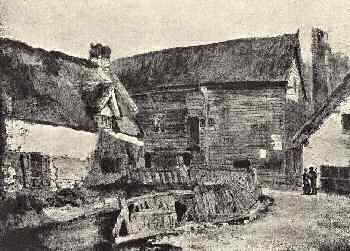 |
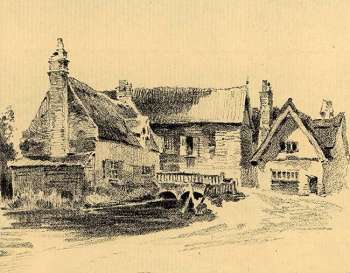 |
|
Watercolour
by John Sell Cotman c.1830
|
Lakenham
Mill & post office c.1850 |
|
Lakenham Mill was built and operated as a corn mill but by the 1830s it was being used as a yarn mill. In 1836 it was being run by Dodshon Blake, a gentleman from Magdalen Street, Norwich who was also running the Norwich Yarn Co in Fishergate Street. The tithe map of 1840 shows that Edward and Robert Wiffin Blake (presumably sons of Dodshon Blake) were running both Lakenham and St Edmunds Mill in Fishergate spinning mohair and worsted. By 1845 steam powered looms were installed at Lakenham and the mill had a staff of 100 males and 200 females. |
Royal Exchange Fire Insurance policy 94858 |
Heny. Richards of Lakenham in the County of Norfolk. On a Water Corn Millhouse timber built and tiled and on the Mills therein together with the running tackle and other parts of the Machinery belonging thereto situate adjoining the Red Lion in Lakenham aforesaid - £750. On Utensils and Trade therein - £350. On a House brick and thatchd in his own Occupatn, near - £70. On Houshold Furniture therein - £30. On a Stable and Workshop adjoining near - £20. On a House situate on the Opposite side of the Road near in the Occuptn. of himself or Servants - £180. On a Barn and Workshops adjoining situate behind - £130. On Utensils and Trade therein - £250. On a Stable situate near - £250 The said Buildings except those otherwise mentd. are brick and tiled except part of the Gables which are plaister on timber and plaister built. 17th October 1785 |
Royal Exchange Fire Insurance policy 109162 |
Heny. Richards of Lakenham in the County of Norfolk, Miller. On his Dwelling House brick built and thatchd situate in Lakenham aforesaid - £70. On Houshold Furniture therein - £50. On Printed Books in the Same - £70. On a Water Corn Millhouse timber built & tiled & on the Mills therein together with the Runninh Tackle & other parts of the Machinery belg. thereto situate near and adjoining the Red Lion - £750. On Utensils & Trade therein - £260. (Renewed from No. 94858). 21st November 1788 |
|
Messrs. J. and J. Colman, Stoke. I beg to lay before you an Estimate to take out the old Water Wheel at Lakenham Mills and to make a new cast iron one fourteen feet six inches diameter and fourteen feet wide, viz, with eight half rings fitted and bolted together with good strong bolts, and cast iron buckets bolted to the wheel, two new staple posts of cast iron, mud cill fourteen by seven and cap cill eight by eight. New cast iron steadfast breast, oak draw breast four inches thick put together with good cleats and ham'd iron bolts through the breast. Two cast iron racks, two pinions, two rolls, ham'd iron laying shaft with iron carriages and bolts, cast iron worm & wheel, carriages, plumblocks, bolts and crank. to make a new cast iron pit wheel in halves, fitted and bolted together with good strong bolts, new cast iron wallower, pitched, trimmed, and hung with screws, to gear the crown wheel, to take down the spur wheel shaft of the first motion and refix it further down stream with a new bridgen post to do. The machinery driving the rolls to be taken down and Refixed, new cast iron Water Wheel shaft with bearings, brasses &c. Floats and back boards to be found by you. The above work made and fixed in a workmanlike manner for the Sum of Three Hundred and Forty Seven Pounds, Ten Shillings. |
|
£347.10.0 May 1850 |
I remain. Your Obedt. & Hble. Servt. John S. Buttifant. |
|
King Street, Norwich, July 11th 1865. Repairs required to be done at Lakenham Mills. First Water Wheel to be lifted and leveled with new Packings for same with New Shroudings & Float Boards, bolts, & Nuts where required with Mens Time to ditto. New Cast Iron Pit Wheel ring in 6 Segments 14ft. diar, 3 inch Pitch, 9 inches broad on Face and new Patterns for Do. Bolts & Nuts where required with Mens Time fitting & Fixing. One New Cast Iron Pit Wheel Pinion 3ft 6in diar, with new Pattern to Do, bored and fitted with Mens Time. 1 New Cast Iron Bracket for Breast Gear. To repair Waste sluice gate with 2 New Pinions, 1 New Rack, new Keys with Mens Time to Do. To lift & level first motion Counter Shaft, 2 New Gun Metal Bearings bored and fitted with Men's Time. To lift Upright Shaft, one pair Gun Metal Bearings, One Do. for Toe, regear 5 feet Mortice Wheel & retrim 3 Iron Tooth wheels with Men's Time to same. To Lift and level 2nd motion Shafting on Ground Floor, repair Keeps at each end, one 22 inch Driving Drum, new dies for Fork Lever, 20 new Brass Bearings for ditto and retrim 1 Pair of 4ft Iron gear Wheels with Mens Time. To Lift and level Shafting in Mechanic's Rooms, 2 Pairs of New Brasses, retrim geers with Men's Time to ditto. 2 New Grates to Wash house (about 1 Cwt. 2 Qrs.) To lift & Level Shafting in Spinning room, 7 New Brass Bearings, retrim Wheels & put in new wood coggs where required with Men's Time to same. Lift and level Shafting in Top Room. one new Brass Bearing, retrim Geers with Men's Time to same. I am willing to undertake to complete all the repairs mentioned in the enclosed of the best material and workmanship for the sum of One Hundred and thirty nine pounds, eight shillings. £139. 8. 0. The price for Cast Iron Perforated Plates for drying Room floor (about 515 feet Super) would be Forty Two Pounds. £42. 0. 0. Your Obedt. Servt, pro Thomas Smithdale, T. S. Junr. |
Lakenham mill was last listed as a yarn mill in 1890 and by 1892 Henry Hollidge was using the mill to crush grain probably for animal feed. This era ended with the great fire of 31st March 1908. William Moyes then continued the grist trade until 1914. |
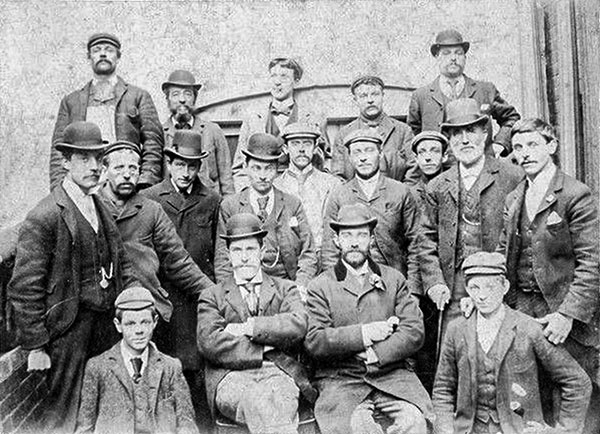 |
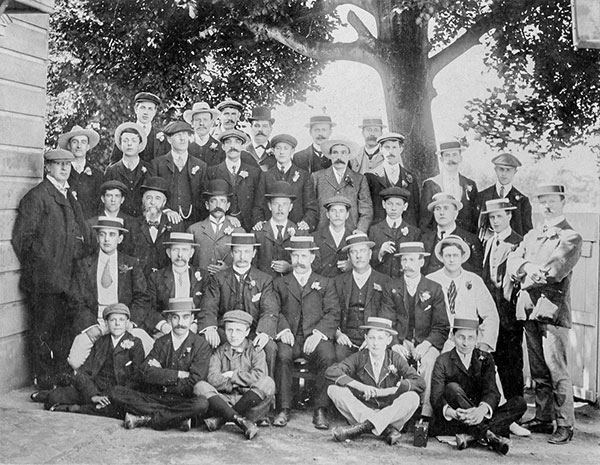 |
Lakenham Mill staff c.1899 |
|
 |
Lakenham
Mill, Cock Inn and Post Office c.1900 |
GREAT FIRE AT NORWICHOLD LAKENHAM MILLS DESTROYED |
Few places on the outskirt of Norwich are better known than the picturesque spot at Old Lakenham at the foot of Long John Hill, where the grist mills of Mr Hollidge are faced by the pleasant-looking Cock Inn, with a large pond in front. Anyone taking the trouble to journey there today will see a great change, as the big mill is a mere shell, the Cock Inn is in ruins, and a cottage adjoining the mill is also burnt out. All this destruction was wrought by a fire which broke out in the mill about midnight, and, fanned by a strong breeze, spread to the other places, so that in a very short time the whole aspect of the locality had been changed. |
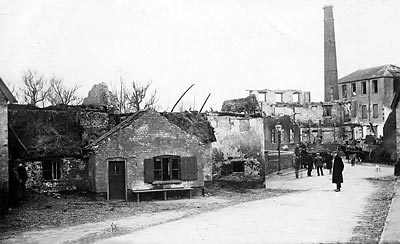 |
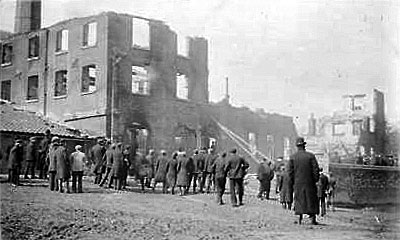 |
Mill remains after the fire on 31st March 1908 |
|
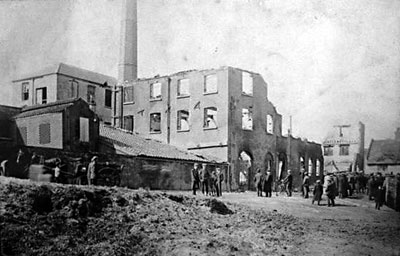 |
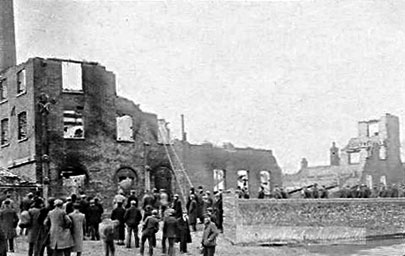 |
Mill remains after the fire on 31st March 1908 |
|
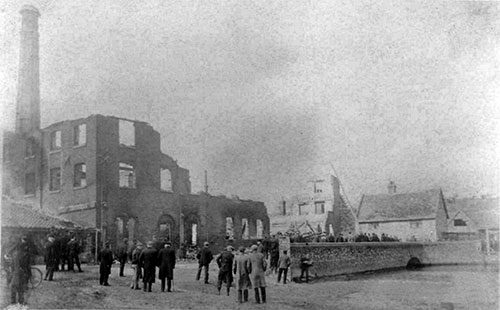 |
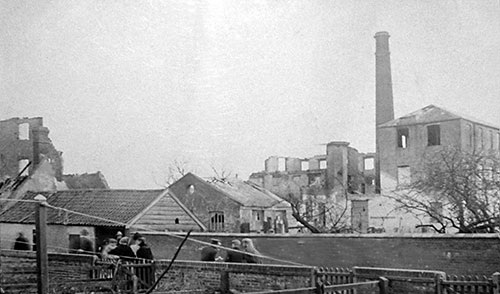 |
Mill remains after the fire on 31st March 1908 |
|
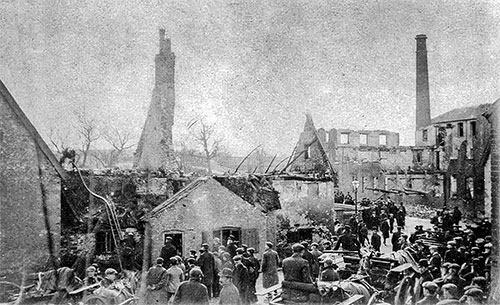 |
 |
Fire aftermath 1908 |
|
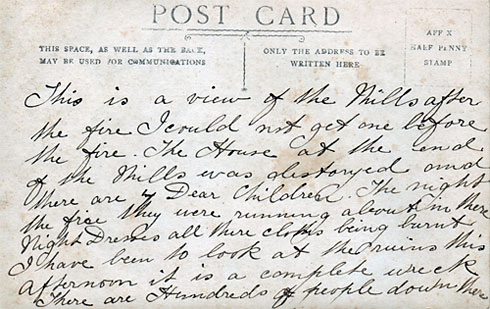 |
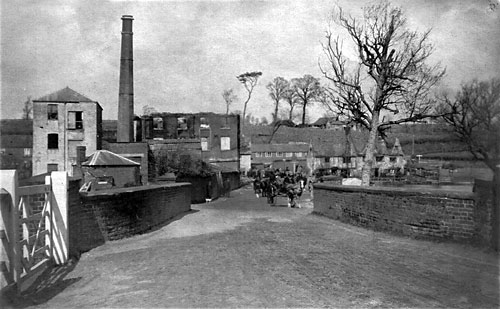 |
|
Mill shell from a postcard after the fire on 31st March 1908 |
|
Transcript from the above postcard: This is a view of the Mills after the fire I could not get there before the fire. The House at the end of the Mills was destroyed and there are 4 Dear Children. The night the fire they were running about in there Night Dresses all there clothes being burnt. I have been to look at the ruins this afternoon it is a complete wreck. There are Hundreds of people down there. |
|
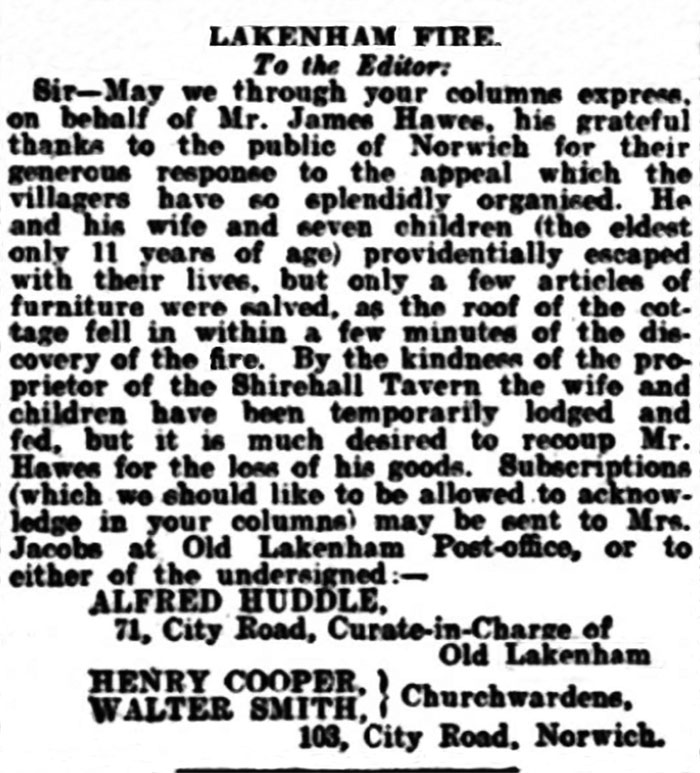 Eastern Daily Press - 7th April 1908 |
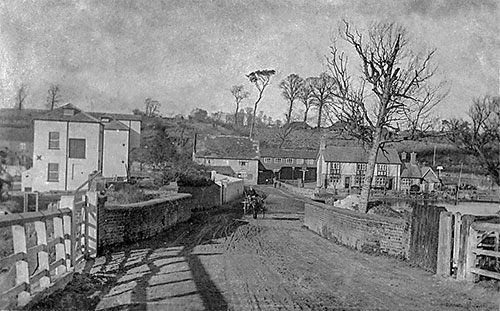 |
New and smaller mill c.1910 |
|
In 1915 W.T. Jordan lived in the mill house and used the leased mill as a toy workshop. He then sold his toys in his own shop, which was the previous factory, at 5 Golden Ball Street in Norwich. The shop was later demolished to make way for road widening. In January 1970 his son and daughter were still living in the mill house. |
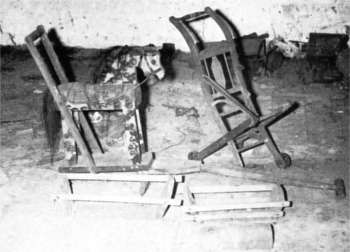 |
|
Toys
from c.1916 found in the mill 11th June 1978
|
From the NIAS Journal Vol. 2, No. 4, 1979 Faden's map of 1797 shows no mill at Lakenham at that date; the earliest available directory evidence is the White's directory of 1836 which lists the LAKENHAM YARN COMPANY on the site, under the management of Dodshon Blake, gent., of Magdalen Street, Norwich. Mr. Blake was at the time also in charge of the Norwich Yarn Company in Fishgate Street, Norwich, so evidently the two mills were under the same ownership at this date. The 1840 Tithe map shows the Lakenham mill built very close to the road, and under the ownership of EDWARD & ROBERT WIFFIN BLAKE, presumably the sons of the previous manager. The Blake family now also owned the St. Edmund's mill in Fishgate Street, both being used for the spinning of mohair and worsted yarns. By 1845 steam-power looms were in use at Lakenham and 100 males and 200 females were employed at the mill. In about 1866-7 both mills were taken over by JOSEPH PARK & SONS of St. James' mill (later to become Jarrold's printing works), and the three sites continued to manufacture mohair and worsted yarns. By 1882 Lakenham mill had been considerably rebuilt and enlarged, the wheel-house now sited further back from the roadside frontage. A boiler house was erected nearby with a tall chimney adjacent, a large steam engine supplementing the water-wheel. It would seem that there were in fact two chimneys, as an old photograph shows one in the mill building itself. Many outbuildings were added, together with workers' cottages, the mill pool was enlarged and the River Yare and nearby Tas underwent a major re-alignment. A wool-combing shed originally stood on the site of the former Martineau Lane Mission not far away. Lakenham finally became a victim of the decline of the wool trade and 1890 sees its final listing as centre of the Norwich yarn industry. It is said that some of the employees went off to work in the Lancashire cotton mills. Lakenham Corn Mills HENRY HOLLIDGE, a corn chandler with premises in Ber Street, Norwich, was installed at the redundant yarn mill by 1892 as a corn merchant. He kept on his business in Ber Street and opened another in Rupert Street. Lakenham mill saw service, probably as a grist-mill producing animal feed, until 1908. It was in 1908 that a disastrous fire engulfed the mill, flying sparks firing the thatched roofs of the surrounding cottages and the Cock Inn opposite. Most of these buildings were destroyed in the blaze, which, it was said at the time, was started by a tramp who got in one night to sleep in the hay, there being bales of chaff and hay on the ground floor and grain on the top floor. Mr. Hollidge's daughter later recalled the smouldering grain still being too hot to stand on, two months after the fire! A new mill, of smaller dimensions this time, was built on the site by the insurance company, but it would seem that Hollidge's customers had meantime taken their trade elsewhere, so he moved on to a windmill at Reedham, which was in turn destroyed by fire in 1912. Alongside the mill the existing three-storey granary had its top floor removed. This building also contained a stable. Although the boiler house itself was retained, the boilers were removed and the chimney dismantled, the recovered brick rubble being used to make concrete for the City of Norwich School playgrounds in Eaton Road. A 1942 cutting from the Eastern Evening News recollected that: "The chimney was taken down step by step by a deaf old man who set about his task in a special way. He climbed up the inside, cutting niches in the brickwork at intervals to set lintels. When at the top he gave a great 'holler' to those below and hacked off the stone coping, and so on till the foot was reached." By 1911 the new mill was taken over by another miller, WILLIAM HENRY MOYES, who continued trading as a grist-mill using water power until 1914 when the tenancy was again for sale, the property being owned by the Trafford Estate. Lakenham Toy Factory W.T.JORDAN (Fretworker) was established in 1886 and ran a business making wooden toys from a shop and workshop at 5 Golden Ball Street, Norwich. He took over the mill on 11.10.1915 and after the Valentine's Day rush for toys, moved into the mill on 15.2.1916 still retaining the shop as an outlet for his products. Wooden horses on four-wheeled trolleys were a speciality of the business. Bullock tails were used to make the man and tail, horse hair being considered not curly enough for the purpose. It is interesting to note that even in those days some manufacturers were aware of the dangers to children in lead-based paints. Mr. Jordan bought his colours in powder form. This was then boiled up in a mixture of whiting and size, the toy finally receiving a coat of spirit varnish. The whiting was obtained from Pearce's Whiting Works in Marston Lane and it is recollected that it came in dried slabs with a curved bottom - due to being set out to dry on pantiles! Amongst other articles manufactured were: child's washstands and wheelbarrows, doll's pushchairs, furniture legs and fretwork for decorative household and church furniture. The granary was used as a store and the boiler house saw use as a pigsty before becoming a garage until it became dangerous, when the old stables were used for this purpose. The millstones and milling machinery were taken out and sold at a later date to other local water-mills. Two batches of twenty-six German prisoners of war under the care of a guard were installed in the granary stables in 1918, their allotted task being to dredge the rivers and dykes using hand-scoops and wheelbarrows. Despite the Armistice a few days later, they stayed on the job for twenty-one months. Besides powering the wood-working plant, the wheel was also used to pump water into Lakenham swimming baths just downstream. The mill was paid for providing this facility for a 20-week season once a year. In 1937 Norwich Corporation bought and demolished the shop in Golden Ball Street for road widening. Due to the development of the mechanical toy, the wooden variety became unprofitable, so the Lakenham factory ceased toy production at the same time. Lakenham Saw Mills The mill continued for a further ten years as a saw mill, work much more to the liking of Mr. Jordan Jnr. River bank protection work formed the mainstay of the production, trees being sawn outside on a rack-bench driven by the water-wheel via a pulley on the outside end wall. The wheel did not prove entirely satisfactory at this task and in 1939 a Fowler steam traction engine was brought in to de=rive the saw-bench. The engine continued at work until 1945-6 when it was sold to a nursery for the sterilization of glass-houses. Attempts were made in the 1940s to drive a saw-bench inside the granary building with a 3½ hp petrol engine, but this did not prove too successful so it was sent off to power a chaff-cutter elsewhere. During the 1939-45 war the Norwich Corporation decided to use mains water for the Lakenham swimming baths, probably due to pollution in the river water. When the river supply to the baths was shut off it caused some difficulties at the mill as the tail-race water was now impeded in its flow. The Norwich Corporation bought the property from the Trafford Estate in about 1947, the saw mill closing in the same year, although the buildings remained in use for storage purposes. Mr. Jordan Jnr. continued in business on various river drainage contracts and the water-wheel was last used in the late 1950s to power a grindstone for sharpening the tools necessary for the job. N.I.A.S. Survey Following negotiations with Mr. W. E. Jordan, the Society was given the freedom of the site on Sunday, 11 June 1978, and with a turnout of fourteen members the site was fairly well recorded on the day. The mill itself is a three-storey brick building of modest proportions, roofed in slate with a weather-boarded lucum, or loading bay, jutting out from the two upper floors. It provides a stark contrast to the modern housing estate on the other side of Mansfield Lane. The construction is unusual and, with hindsight, of defective design. It consists of brick quoins, door, window frames and roof line. The bricks are standard sized, laid in header and stretcher bond. The infilling is of assorted random bricks mortared together, probably re-used from the burnt-out mill, the whole then being whitewashed. The random brickwork is not keyed into the bonded quoins and very soon after it was built large vertical cracks appeared, due to the constant vibration of the wheel. Even the immediate installation of tie-beams did not remedy this and the cracks gape to this day. There is some trace of cottage flooring within the Mansfield Lane boundary wall, and the old random flint and brick house on the corner of the lane is of interest. A 1967 E.E.N. article by Geoffrey Goreham reads: "Inside, the huge undershot wheel stands idle, caged, magnificent and silent although theoretically it could still perform". Magnificent it certainly is, almost fifteen feet high and nearly ten feet across, the thirty wooden paddles being bolted to intricate cast iron brackets. The wheel appears much too large for a mill of this size and would seem to date from the second yarn mill (a revolving water-wheel is unlikely to have caught fire). Also it stands on the same site as before. The sluice-gear still controls the flow of the River Yare through the mill. The gearing, governor and shafting are still intact connecting to the shafting on the first floor, where the various lathes planers and saws still remain as left in 1937. The second floor houses an interesting old fretsaw; both floors contain scattered oddments of unfinished toys and fretwork, including a pair of near-complete wooden horses. Some of the more modern machinery on site was never actually used here; it was obtained from the Collings' estate workshops at Bacton. The pulley on the wall outside is on an extension of the ground floor shafting, allowing a rack-saw bench in the yard to be driven by the water-wheel. The gearing used to increase the speed of the saw lies on the ground outside. The adjacent granary building is of similar size but of different construction, two storeys high with a roof of slate. The brickwork is of more usual horizontal courses, some headers, some stretchers, with soldiers over the doors and windows. The walls are tied with beams and tie-plates again with whitewash painted over. Mr. Jordan thought that it was older than the mill building and had had the top storey removed at some time. It suffered the bombs of the 1949-45 war and the windows and roof were later badly repaired by the War Damage Commission. The ground floor is a large store-room with stables at the mill end, latterly used as a garage. The floor above consists of one large room with windows on all sides. A hole in the east ground floor wall remains as a reminder of the P.O.W.s' tenancy - being the outlet for the chimney of their tortoise-stove. The boiler house foundations are still extant, being finally bulldozed in 1973 after standing for some time in a semi-collapsed state. Of the chimney foundations there are no remains visible. The site is close to the convergence of the Rivers Yare and Tas. The course of the latter was in earlier days diverted when the Norwich-Cambridge railway line was built, this being a cheaper alternative to bridging it. The remnants of the old Tas form a backwater to the east of the mill, receiving the overflow leat from the Yare in order to keep the flow to the mill at a manageable level. The two rivers converge below the Lakenham swimming baths. A survey of Norfolk watermills in 1969 revealed that eighteen remain in working order, a further thirty-eight are still standing and over forty consist of remains or empty sites. It is just possible that Lakenham may one day leave the second category and join the first. In conclusion I would like to thank Mr. W. E. Jordan for his patience and the N.I.A.S. members who helped in the survey and research. Chris Fisher |
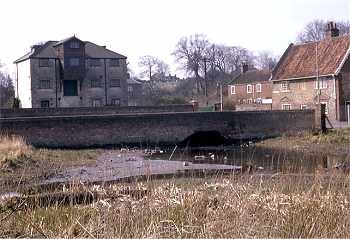 |
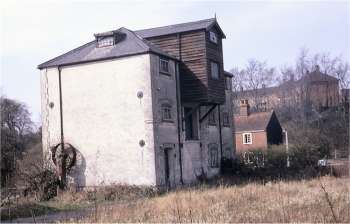 |
|
Becoming
derelict in April 1967
|
|
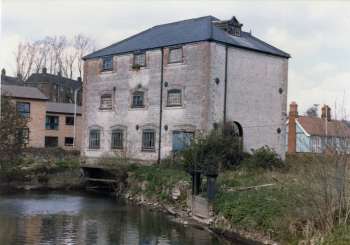 |
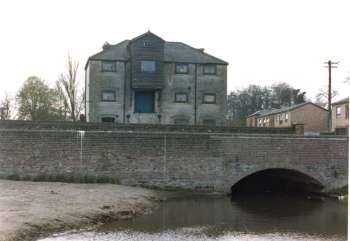 |
|
Headrace April 1977
|
Tailrace April 1977 |
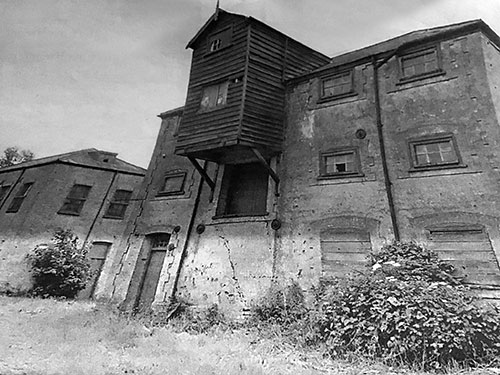 |
c.1978 |
Hopes of Old Lakenham Mill being restored |
Plans to restore Old Lakenham Mill as a working water mill moved a step nearer yesterday when Norwich amenities committee backed the sale of the near-derelict building to the tenant. |
SUPPORTED |
At present, the mill is used for the storage of tools and equipment, said a report by estates surveyor Mr. Peter Lloyd. It added that the director of planning and environment, Mr. Peter Cooper, felt the mill should be restored and that the public should have access by appointment. The committee yesterday supported the sale for £3500 of the mill and nearly an acre of the surrounding land to Mr. Jordan, on condition that it had first option to buy the property back if it was decided to sell within 10 years. However, it was felt that adjoining land already leased to Mr. Jordan should continue to be leased as it would probably be needed for the riverside walk. The amenities committee will now go to a housing sub-committee which deferred a decision when the matter came up before it last month. Eastern Daily Press - September 1978 |
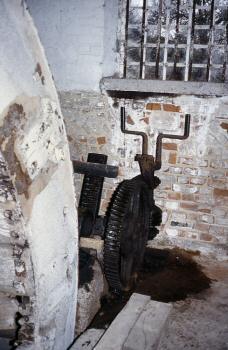 |
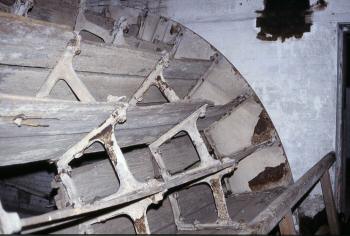 |
|
Wheel and sluicegear February 1983
|
The wheel February 1983 |
In April 2006 the mill was advertised for sale on the internet through John D. Wood & Co. for a guide price of £499,950. Accommodation included 3 bedrooms, 3 bathrooms and 3 reception rooms, along with some of the original machinery including the wheel. |
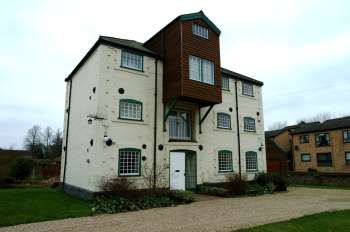 |
|
15th
February 2003
|
We have just discovered that my grandmother and her parents (James & Eliza Hawes plus children) were living in the thatched cottage next to the mill at the time of the fire. |
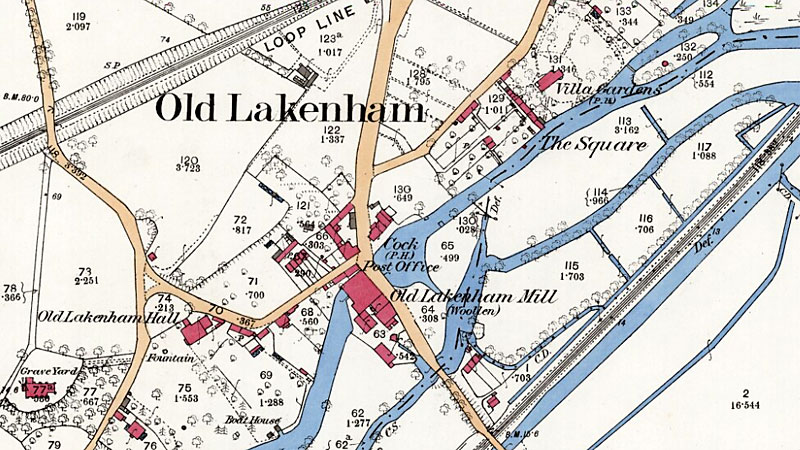 |
O. S. Map 1880 |
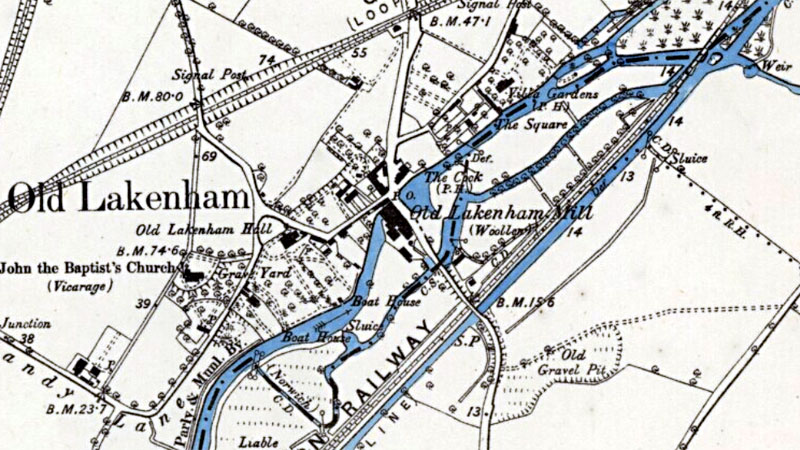 |
O. S. Map 1881 |
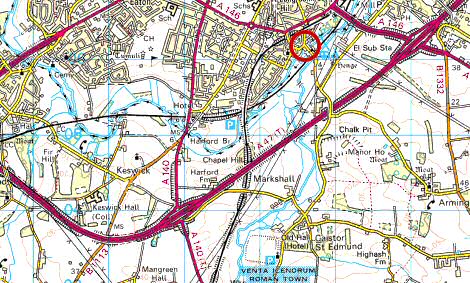 |
O.S. Map 2005 Image reproduced under licence from Ordnance Survey |
1864: John Brown, millwright, Lakenham |
|
October 1785: Henry Richards, miller, insured the mill for £750 with Royal Exchange Fire Insurance |
If you have any memories, anecdotes or photos please let us know and we may be able to use them to update the site. By all means telephone 07836 675369 or
|
| Nat Grid Ref TG23600616 | Copyright © Jonathan Neville 2003 |